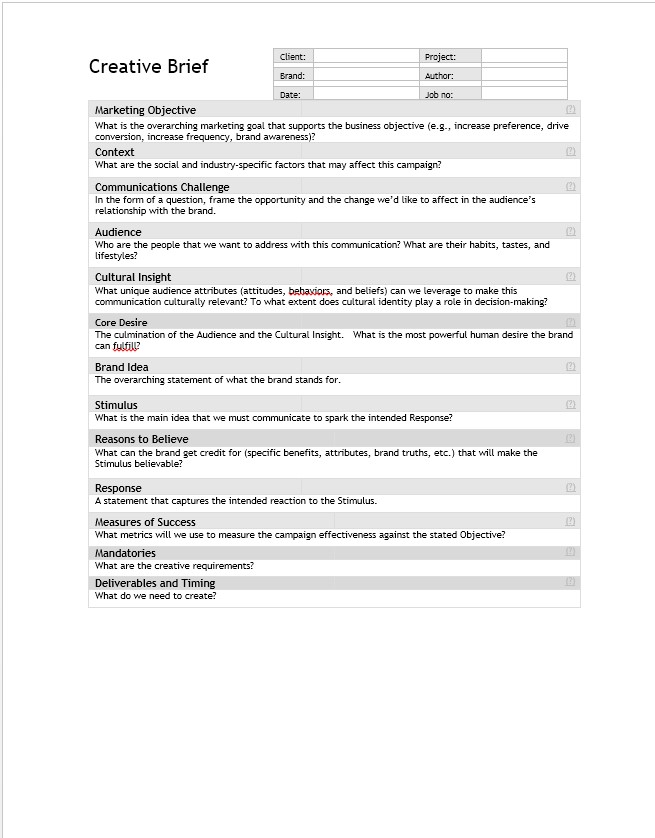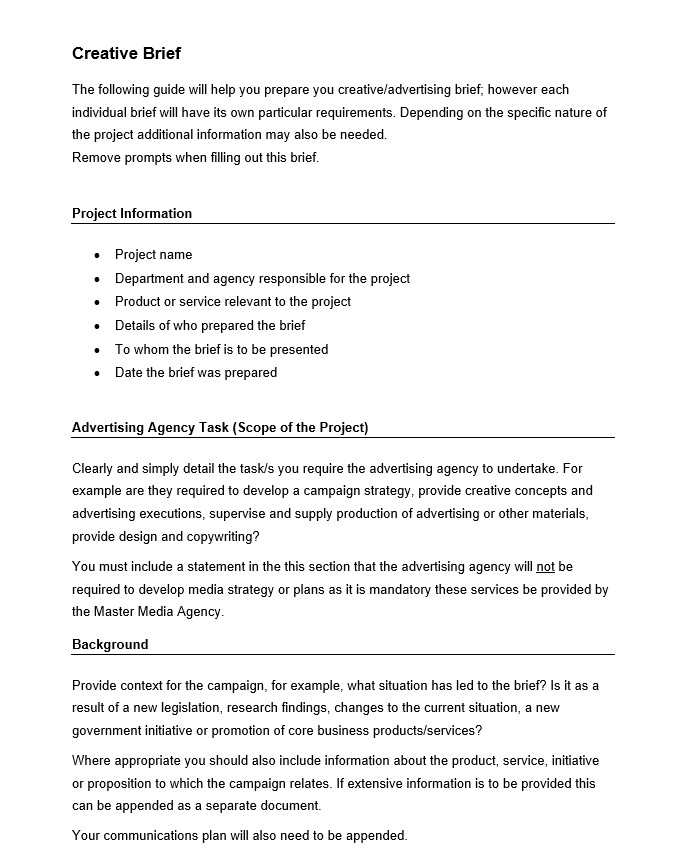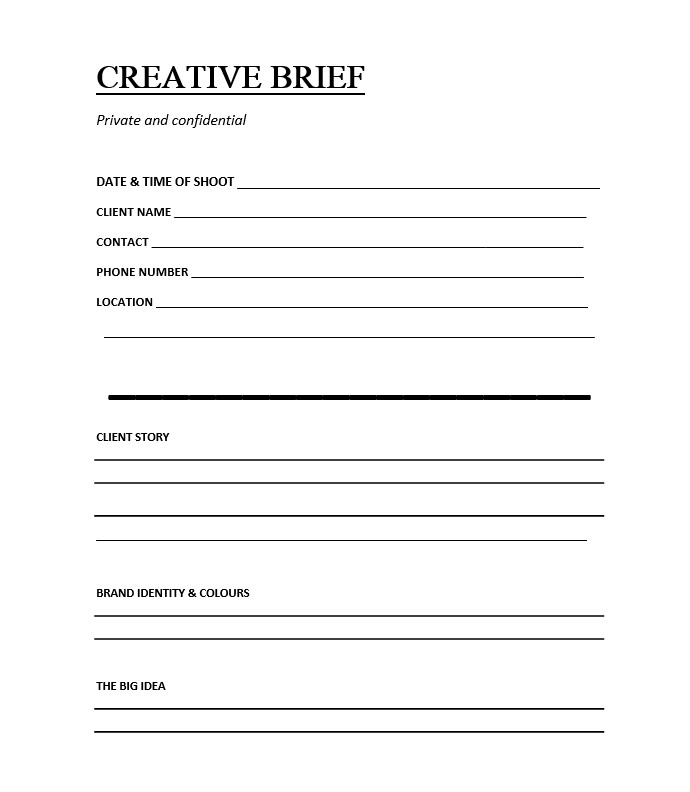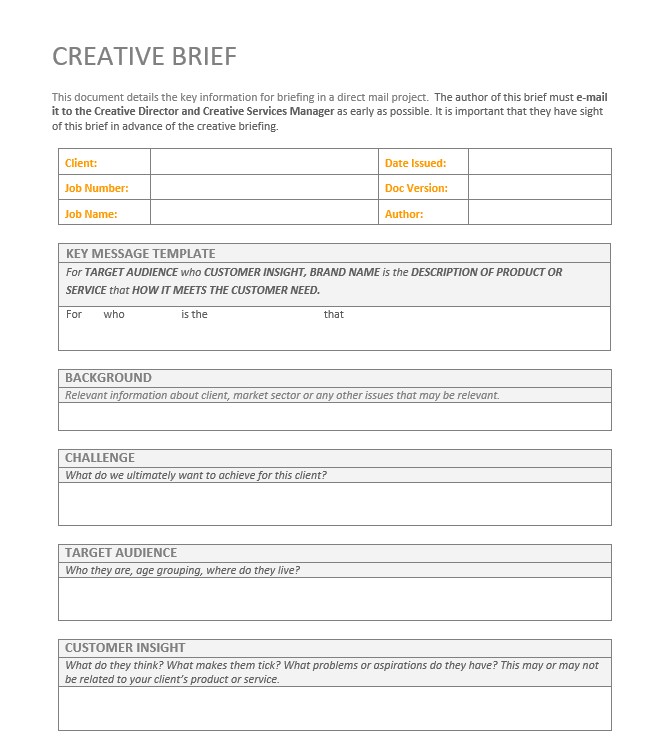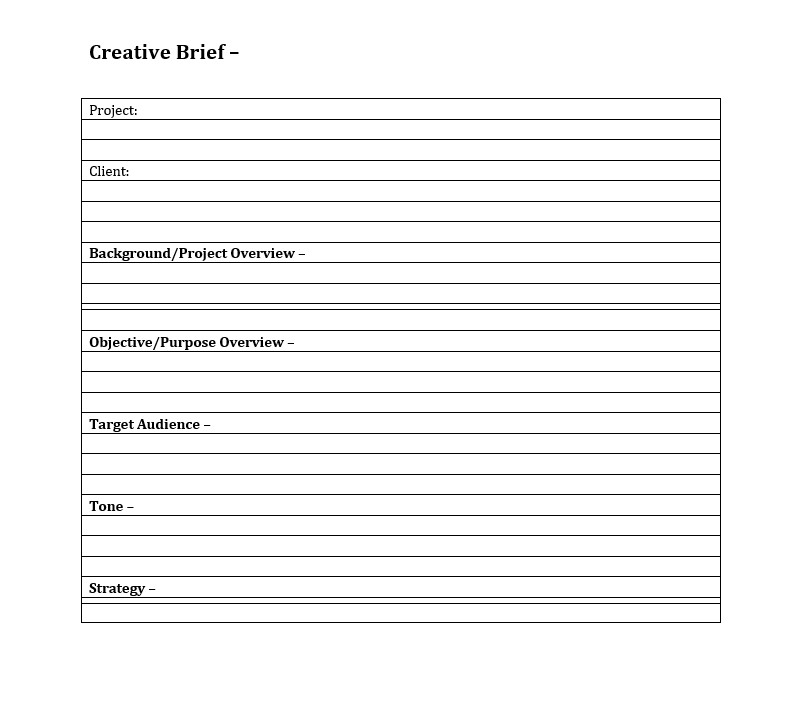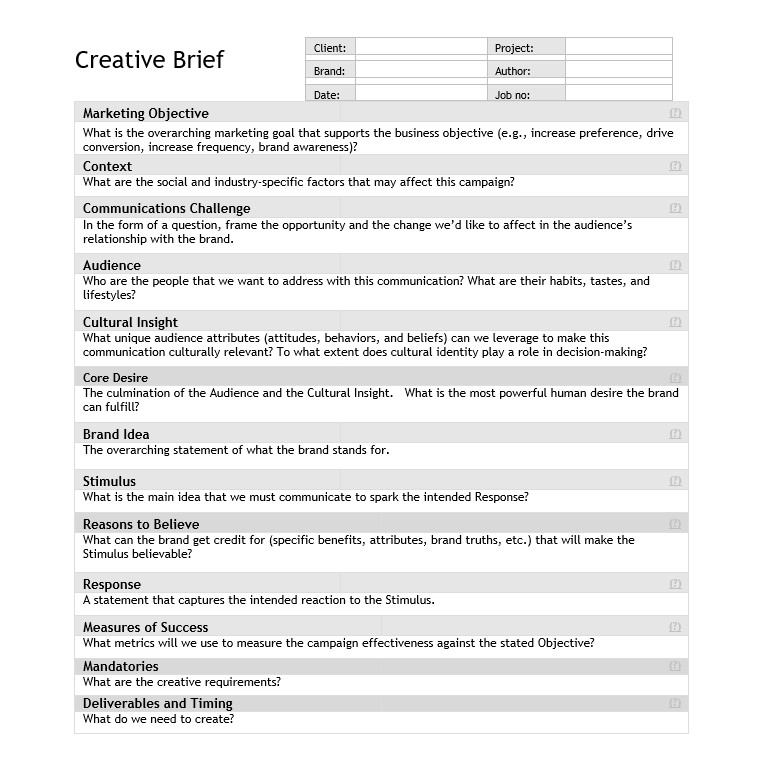A Creative Brief is a plan that professionals in creative fields use to outline the objectives and anticipations of a project. It functions as a guiding document, providing a clear idea for the project and providing all stakeholders are aligned in their understanding and approach.
If you are a creative agency, you will most likely have a creative brief template to follow. This basic template provides key information about your project, including the target audience, execution strategy, and client guidelines. The purpose of a creative brief is to inform a graphic designer of the objectives of a campaign. The purpose of this document is to help the graphic design agency decide if the project is worth pursuing. It can also be used internally for a variety of purposes.
Creative Brief
Before you start developing your project, you need to define your main objective. The main objective is the main goal of the project and should showcase a problem your target audience faces and the solution that the company offers. For example, PayPal is a company that allows users to have a virtual wallet to pay for their online purchases. Having a clear vision for the project helps the creative team develop the right project strategy for a campaign. It is a great way to explain to your team what your business is all about.
If you do not have a creative brief template, try to research online. There are plenty of examples available online, which you can customize as per your needs. There are also templates for ad campaigns and advertising and marketing agencies. Regardless of the type of creative brief you need to create, these documents will help you get started. A template will help you keep your creative brief concise and professional. You can also add a few extra details to make it more effective.
The Importance of a Creative Brief in Project Management
It is the cornerstone of any creative project, providing a comprehensive overview that guides all involved parties throughout its lifecycle. Here are the key reasons why a Creative Brief is indispensable in project management:
- Fosters Effective Communication: Communication tool bridging the gap between customers, project managers, and creative teams. It confirms that everyone comprehends the project’s objectives, deliverables, and expectations, minimizing the risk of miscommunication and misconceptions.
- Provides Strategic Direction: outlines the strategic direction for the project. It encapsulates the project’s objectives, target audience, unique selling proposition, and deliverables, providing a roadmap that shows the innovative process and guarantees that all activities are aligned with the project’s plans.
- Enhances Efficiency: allows groups to operate more efficiently by delivering a clear task overview. It helps to focus efforts on what truly matters for the project, decreasing destroyed time and resources on irrelevant tasks. This focus and clarity can significantly enhance the productivity of the innovative group.
- Facilitates Evaluation: delivers a benchmark against which the project’s success can be measured. Outlining clear and measurable objectives allows for objectively evaluating the project’s outcomes. It can deliver useful insights for future projects and contribute to continuously improving the organization’s project management practices.
- Mitigates Risks: By setting clear expectations from the outset, a Creative Brief can assist in mitigating risks associated with the project. It ensures that all parties are aligned in their understanding and expectations, reducing the likelihood of conflicts and disagreements.
Its importance cannot be overstated in ensuring the smooth execution and successful outcome of any creative project.
The Process of Writing a Creative Brief
It is a method exercise that combines analysis, synthesis, and clear communication. Here is a guide to this process:
- Step 1: Gather Information: The first step is writing and collecting all suitable details about the project. It contains an understanding of the project’s goal, objectives, target audience, unique selling proposition, and deliverables. It also involves understanding the project’s constraints, such as its budget and schedule.
- Step 2: Analyze the Information: Once all the data has been gathered, the next step is to analyze it. It involves identifying the key insights that will guide the project, understanding the requirements and manners of the target audience, and determining the project’s unique aspects that set it apart from its competitors.
- Step 3: Define the Objectives: Based on the analysis, define clear and measurable objectives for the project. These objectives should align with the overall goals of the organization or client and should provide a clear direction for the project.
- Step 4: Identify the Target Audience: Identify the demographic, psychographic, and behavioral characteristics. This understanding will direct the project’s development and ensure it resonates with its intended audience.
- Step 5: Craft the Unique Selling Proposition: Founded on understanding the task and its mark audience, craft a unique selling proposition that sets the project apart from its competitors. This proposition should articulate the project’s unique value or benefit to its target audience.
- Step 6: Outline the Deliverables: Outline the actual outcomes of the task. These deliverables should align with the scheme’s objectives and deliver a clear vision of what the scheme aims to make.
- Step 7: Set the Budget and Schedule: Set a realistic budget and schedule based on the project’s requirements and available resources. It will deliver a framework within which the task must operate and remain within its economic and temporal conditions.
- Step 8: Write the Creative Brief: With all the details in place, the final step is to write the Creative Brief. This record should be brief, precise, and comprehensive, providing a complete overview of the project and its objectives.
Creative Brief Template
If you are looking for a creative brief template for a project, start by finding an agency. You can find thousands of agencies from across the world on the Agency Directory. Then, upload your document and double-check all the details for an accurate and timely project. After you’ve made a list of agencies, you can search for the one that meets your needs. Then, you can choose the one that is best suited to your project and budget.
Creative Brief Example
A Creative Brief Template for a project should outline the goals and objectives of the project. It should provide background information about the company’s brand. The objectives of a project should be well-defined and clearly stated. The team should work toward achieving the goals of the client. Then, the creative brief will help the team align. Then, a good template can be used to develop a template for a specific project.
Creative Brief Sample
The creative Brief Template for a project should also have clear project boundaries and expectations. Besides being a time-consuming document, it should also be easy to customize. It should contain fields like preferred file formats, colour codes, and branding. If you’re a graphic designer, the template should have fields for the colour palette and preferred file types. If you’re a developer, you can also include a copy of your current brief and a link to the project’s website.
Creative Brief Template PDF
A creative brief template for a project can be a great tool for creative agencies. It introduces the campaign and project goals, summarizes the key deliverables, and is an essential part of any marketing campaign. Using a Creative Brief template is a great way to ensure that your team is working towards the desired results, while also ensuring that you get the best value for your money. The template can be used for any type of project, from small businesses to large businesses.
It is crucial to define the target audience of a creative brief. A good creative brief will include the core elements of your brand statement. In addition to these, it should also include specific values and point of view. All of these elements are important, but it’s best to keep the creative brief as direct as possible. You’ll want your agency to deliver the best results for your project, so you need to ensure that it’s as clear as possible.
Creative Brief Template Word
Creative Brief Template Elements
The creative brief must be planned carefully because it is important for the advertising or marketing campaign. It can be found in the tool or document form. It will be the map which will be followed by the creative team. It can show the way to start the project. It will also show the way to follow through the project. For creating the right template for this purpose, there are some elements which must be included although there is no fixed and specific format which can be found for this tool or document.
Company Description
Every company has a specific purpose and value. It is important for making sure that the company information must be shared with the creative team or the designer of the brief. This way, the team will be able to understand the project context. At the same time, there will also be a better understanding of the business nature of the company. People can include the links to the website of the company as well to the creative team. Other important background materials can also be included.
Project Summary
In the creative brief template, it is also important to include the summary of the project. It means that they have to talk about the description of the project and the purpose of the project. The essential information about the project will be useful for the creative team so they will be able to use their creativity more for doing the project since they are motivated by the information.
Objectives Explanation
There is no doubt that people have to include the objectives explanation in the brief because it is the most crucial part of the document. Before people can process the project further, they have to make proper thought about the objectives as well as strategies. They have to understand the reason why the project is needed. The goals of the project also need to be understood besides the project objectives.
Project Target Audience
Every project is made to grab the success and it can be done if they consider the target audience of the project. This must be done from the very beginning of the project planning. They have to share the information about the target audience, behavioral, and demographic insight must also be included in the brief.
More Things
There are more elements which must be included in the brief including the required deliverables outline, competition information, and more details about the project just like in the creative brief sample.
Creating a solid Creative Brief Template is a great way to ensure your deliverables match your goals and expectations. Using a template for this task is a valuable investment that will help you save money in the long run. And it will make the whole process easier and more efficient. So what are you waiting for? Give your Creative Brief a try and start building a successful creative brief today!
How to Define Clear and Measurable Objectives
Establishing clear and measurable objectives is a cornerstone in forming a Creative Brief. These objectives illuminate the project’s path, delineating its goals and setting a standard for assessing its success. Here is a step to crafting such goals:
- Comprehend the Project’s Goal: Start by thoroughly comprehending the project’s goal. Determinate the issue it seeks to solve and its raison d’être. This understanding lays the groundwork for the objectives.
- Harmonize with Broader Goals: It should harmonize with the organization’s or client’s overarching goals. It confirms that the project’s contributions align with the broader strategic vision, enhancing its value and relevance.
- Employ the SMART Framework: Use the SMART (Specific, Measurable, Achievable, Relevant, Time-bound) framework to shape your goals. It assures your goals are precise, quantifiable, attainable, pertinent, and time-specific.
- Specific: It should be explicit and unambiguous, clearly articulating the project’s goals.
- Measurable: It should be quantifiable, incorporating a metric for evaluating their achievement.
- Achievable: It should be practical, presenting a challenge yet remaining feasible, given the project’s help and constraints.
- Relevant: It should be pertinent to the project’s and the organization’s or client’s goals.
- Time-bound: It should have a defined timeframe, providing a deadline for their achievement and facilitating progress tracking.
- Iterate and Refine: As the project evolves, so may the need to refine the objectives. Regularly review and adjust the objectives to ensure their continued relevance and achievability.
You can craft clear and measurable objectives that provide robust direction for your project and a definitive standard for gauging its success.
Understanding and Defining the Target Audience
Learning and determining your target audience is a multi-step process:
- Demographic Identification: Begin by determining the basic demographic characteristics of your audience, such as age, gender, background, revenue, education, and employment. It gives a general idea of who your audience is.
- Psychographic Understanding: Above demographics, delve into the psychographic traits of your audience, including their interests, attitudes, company values, manners, and lifestyle options. This data delivers deeper insights into your audience’s reasons and possible responses to your project.
- Consumer Behavior Analysis: Study your target audience’s behavior. Understand their interactions with products or services like yours, purchasing routines, and preferred information channels. This understanding can guide you in tailoring your project to your audience’s requirements and preferences.
- Market Research: Conduct market research to gain valuable wisdom in your mark audience. It could involve surveys, focus groups, interviews, or analysis of existing data. The goal is to amass as much data as feasible regarding your audience to guide your project’s development.
- Audience Persona Creation: Based on your study, build audience personas. These elaborate models of different audience features can help you imagine your audience and keep their project requirements and choices central to your project development.
- Ongoing Refinement: Understanding your target audience is an ongoing process. As client choices and behaviors evolve, you must frequently refine your understanding. Regularly check and update your audience personas to confirm they stay accurate and appropriate.
Crafting a Unique Selling Proposition
A USP articulates your project’s unique value, distinguishing it from competitors. Here is a condensed guide to crafting a USP:
- Understand Your Project: Comprehend your project’s uniqueness, the problem it solves, and the benefits it offers.
- Know Your Audience: Comprehend your audience’s requirements and tastes. Your USP should address these and emphasize how your project meets their requirements uniquely.
- Analyze Competitors: Comprehend your competitors’ selling points and market position to identify differentiation opportunities.
- Identify Unique Strengths: Determine what positions your project apart, be it a special part, innovative approach, superior quality, or exceptional service.
- Keep It Simple and Clear: Ensure your USP is understandable and communicable. Avoid vocabulary and complexity.
- Be Specific: Create your USP concrete and detailed. For instance, rather than speaking, “We offer high-quality products,” say, “Our products are made with premium materials and undergo rigorous quality testing.”
- Test and Refine Your USP: Test with your mark audience and distill it founded on their feedback.
A potent USP can significantly contribute to your project’s success.
Advantages of Using a Creative Brief
The value of investing time and effort into creating a comprehensive Creative Brief.
- Clarity and Direction: A creative brief clearly understands the project’s goals and objectives. It serves as a roadmap, guiding the creative team on what needs to be achieved.
- Efficiency: By outlining the project’s scope, target audience, and objectives, a creative brief helps the team focus their efforts, reducing wasted time and resources on irrelevant tasks.
- Alignment: It ensures all team members, stakeholders, and the client are on the same page regarding the project’s direction and expected outcomes.
- Creativity Enhancement: By providing a clear framework, a creative brief allows the creative team to focus their energy on ideation and execution, fostering more innovative solutions.
- Conflict Reduction: A well-defined creative brief can help prevent misunderstandings and conflicts by setting clear expectations.
- Measurement of Success: It provides a basis for measuring the success of a project by comparing the final deliverables with the initial objectives outlined in the brief.
Outlining the Deliverables
Outlining the deliverables is a crucial step in crafting a Creative Brief. Deliverables are the tangible outcomes or products that result from the project. They provide a clear vision of what the project aims to produce and serve as a benchmark for measuring its success. Here is how to outline the deliverables:
- Understand the Project’s Objectives: Before you outline the deliverables, you must clearly understand the objectives. What is the project aiming to achieve? The deliverables should directly contribute to the achievement of these objectives.
- Identify Tangible Outcomes: Deliverables are tangible outcomes. They could be a completed design, a marketing strategy, a product prototype, a report, or a tangible project result. Identify what tangible outcomes the project will produce.
- Be Specific: Be specific when outlining the deliverables as possible. Instead of “a marketing strategy,” say “a comprehensive marketing strategy including a market analysis, customer segmentation, marketing mix, and implementation plan.”
- Consider the Project’s Phases: If the project has multiple phases, consider what deliverables will be produced at each phase. It can help to manage expectations and ensure that progress is being made throughout the project.
- Include Details: Include as many details as possible about each deliverable. It could include its format, features, components, or other relevant details. The more detailed your outline, the clearer the expectations will be for the project team.
- Align with the Budget and Schedule: Ensure the outlined deliverables are realistic given the project’s budget and schedule. If the deliverables are not feasible within the project’s constraints, they may need to be revised.
You can outline the deliverables for your project. It will provide a clear vision of what the project aims to produce, guide the project team’s efforts, and provide a benchmark for measuring its success.
Setting a Realistic Budget and Schedule
These elements provide a practical framework for the project, ensuring it remains within its financial and temporal constraints. Here is how to set a realistic budget and schedule:
- Understand the Project’s Scope: The first step in setting a budget and schedule is understanding the project’s scope. What are the project’s objectives? What deliverables need to be produced? What resources will be required? A clear understanding of the project’s scope will provide a foundation for the budget and schedule.
- Estimate Costs: Once you understand the project’s scope, you can estimate costs. It has the cost of labor, materials, equipment, software, and any other resources required for the project. Be sure to account for direct costs (those directly associated with the production of the deliverables) and indirect fees (such as overhead costs).
- Develop a Schedule: Established on the project’s size and calculated prices, develop a schedule for the project. It should outline when each stage of the task will begin and end and when each deliverable will be completed. Be sure to allow for contingencies and potential delays.
- Review and Refine: Once you have developed preliminary funding and plan, review them to ensure they are realistic. Are the cost estimates accurate? Is the plan feasible? If necessary, refine the funding and plan to ensure they are realistic and achievable.
- Communicate the Budget and Schedule: Once the funding and program have been finalized, share them with all stakeholders. It contains the project group, the buyer, and other appropriate parties. Clear communication will ensure that everyone has the same understanding and anticipations.
- Monitor and Adjust: Once the project is underway, monitor the funding and plan regularly to confirm that the project stays on track. Make adjustments to maintain the project within its funding and plan if necessary.
You can set a realistic budget and schedule for your project. It will provide a practical framework for the project, ensuring it remains within its financial and temporal constraints and setting it up for success.
The Role of a Creative Brief in Coordinating Teams
Here is how creative briefs aid in team coordination:
- Provides a Shared Understanding: delivers a shared sense of the project’s goals, deliverables, target audience, unique selling proposition, budget, and schedule. This shared experience ensures all group partners are on the same page and operating towards the same goals.
- Sets Clear Expectations: By outlining the project’s deliverables, budget, and schedule, a Creative Brief scenes clear anticipations for all team members. This clarity reduces the risk of misconceptions and assures everyone knows what is anticipated of them.
- Guides Decision-Making: The information contained in a Creative Brief guides decision-making throughout the project. It delivers a framework for driving decisions that align with the task’s goals and constraints.
- Facilitates Communication: It delivers a reference point for discussions about the project, helping keep them focused and productive.
- Enhances Efficiency: A Creative Brief enhances team efficiency by delivering a precise roadmap for the task. It helps to focus efforts on what truly matters for the project, reducing wasted time and resources on irrelevant tasks.
- Fosters Collaboration: It encourages them to perform jointly to achieve the project’s goals, promoting project collaboration and mutual support.
It provides a shared experience, sets clear anticipations, guides decision-making, facilitates communication, enhances Efficiency, and fosters collaboration. Its role in coordinating teams is crucial for the smooth execution and successful outcome of any project.
Conclusion
It is a powerful tool in project management. It provides a clear vision for the project, aligns the efforts of all stakeholders, and guides the creative process towards achieving the project’s objectives.
By fostering effective communication and setting clear expectations, a Creative Brief streamlines the creative process and paves the way for the successful completion of the project.

The content creator team at calipsotree.com is dedicated to making topics accessible to everyone, with over 9 years of experience in writing and breaking down complex concepts into easy-to-understand articles that answer readers’ financial questions.






